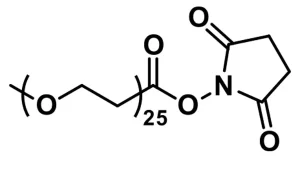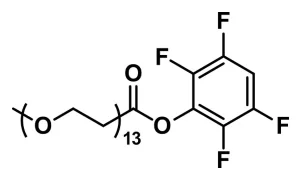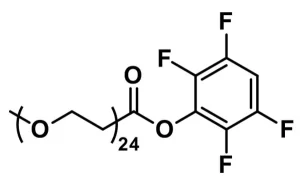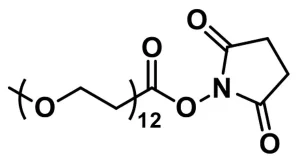m-dPEG®4-NHS ester, product number QBD-10211, is a short (14 atoms, 15.6 Å), methyl-terminated, discrete length polyethylene glycol (dPEG®) spacer designed for the modification of surfaces containing accessible free amines. The carboxyl terminus of the dPEG® spacer is activated with N-hydroxysuccinimide (NHS) and reacts optimally with free amines at pH 7.0 – 7.5. The rate of hydrolysis of the active ester to the carboxylic acid accelerates with increasing pH. Please note that modification of surface amines on biomolecules (e.g., proteins and peptides) with this uncharged, methyl-capped dPEG® spacer may alter the overall charge of the resulting conjugates.
Numerous applications employ this product. The applications in which this product has been successfully employed include:
cell surface engineering;
surface modification of biomolecules;
coating of carbon nanotubes, quantum dots, and other hydrophobic surfaces;
acoustic sensor development;
diagnostic films for pathogen detection, and,
various imaging applications.
m-dPEG®4-NHS ester, product number 10211, is just one member of an extensive line of methyl-terminated dPEG® products that includes dPEG® spacers containing 2 to 49 ethylene glycol units.
| Unit Size | 100 mg, 1000 mg |
|---|---|
| Molecular Weight | 333.33; single compound |
| Chemical formula | C₁₄H₂₃NO₈ |
| CAS | 622405-78-1 |
| Purity | > 98% |
| Spacers | dPEG® Spacer is 14 atoms and 15.600 Å |
| Shipping | Ambient |
| Typical solubility properties (for additional information contact Customer Support) | Methylene chloride, Acetonitrile, DMAC or DMSO. |
| Storage and handling | -20°C; Always let come to room temperature before opening; be careful to limit exposure to moisture and restore under an inert atmosphere; stock solutions can be prepared with dry solvent and kept for several days (freeze when not in use). dPEG® pegylation compounds are generally hygroscopic and should be treated as such. This will be less noticeable with liquids, but the solids will become tacky and difficult to manipulate, if care is not taken to minimize air exposure. |
Greg T. Hermanson, Bioconjugate Techniques, 3rd Edition, Elsevier, Waltham, MA 02451, 2013, ISBN 978-0-12-382239-0; See Chapter 18, Discrete PEG Reagents, pp. 787-821, for a full overview of the dPEG® products.
Molecular Dendritic Transporter Nanoparticle Vectors Provide Efficient Intracellular Delivery of Peptides. Sharon K. Hamilton and Eva Harth. ACS Nano. 2009, 3 (2), pp 402–410. February 5, 2009. DOI: 10.1021/nn800679z.
Synthesis and Characterization of a New class of Cationic Protein Polymers for Multivalent Display and Biomaterial Applications. Nicolynn E. Davis, Lindsay S. Karfield-Sulzer, Sheng Ding, and Annelise E. Barron. Biomacromolecules. 2009, 10 (5), pp 1125–1134. April 10, 2009. DOI: 10.1021/bm801348g.
Noncovalent Cell Surface Engineering with Cationic Graft Copolymers. John T. Wilson, Venkata R. Krishnamurthy, Wanxing Cui, Zheng Qu, and Elliot L. Chaikof. J. Am. Chem. Soc. 2009, 131 (51), pp 18228–18229. December 4, 2009. DOI: 10.1021/ja908887v.
The impact of molecular Weight and PEG Chain Length on the Systemic Pharmacokinetics of PEGylated Poly L-Lysine Dendrimers. Lisa M. Kaminskas, Ben J. Boyd, Peter Karellas, Guy Y. Krippner, Romina Lessene, Brian Kelly, and Christopher J. H. Porter. Mol. Pharmaceutics. 2008, 5 (3), pp 449–463. April 5, 2008. DOI: 10.1021/mp7001208.
Hairpin Structure of a Biarsenical- Tetracysteine Motif Determined by NMR Spectroscopy. Fatemeh Madani, Jesper Lind, Peter Damberg, Stephen R. Adams, Roger Y. Tsien, and Astrid O. Graslund. Journal of the American Chemical Society. 2009, 131 (13), pp 4613–4615. March 12, 2009. DOI: 10.1021/ja809315x.
Improved pharmacokinetics and immunogenicity profile of organophosphorus hydrolase by chemical modification with polyethylene glycol. Boris N. Novikov, Janet K. Grimsley, Rory J. Kern, James R. Wild, Melinda E. Wales. Journal of Controlled Release. 2010, 146 (3) pp 318-325. September 15, 2010. DOI: 10.1016/j.jconrel.2010.06.003.
Bioconjugation of Ln3+-Doped LaF3 Nanoparticles to Avidin. Peter R. Diamente, Robert D. Burke, and Frank C. J. M. van Veggel. Langmuir. 2006, 22 (4) pp 1782–1788. December 30, 2005. DOI: 10.1021/la052589r.
Silica-Shelled Single Quantum Dot Micelles as Imaging Probes with Dual or Multimodality. Rumiana Bakalova, Zhivko Zhelev, Ichio Aoki, Hideki Ohba, Yusuke Imai, and Iwao Kanno. Anal. Chem. 2006, 78 (16) pp 5925–5932. July 14, 2006. DOI: 10.1021/ac060412b.
Multifunctional Separation Mechanism on Poly(oxyethylene) Stationary Phases in Capillary Liquid Chromatography. Toyohide Takeuchi and Lee Wah Lim. Analytical Sciences. 2010, 26 (9) pp 937-941. September 10, 2010. DOI: 10.2116/analsci.26.937
Self-Assembly of Solid-Supported Membranes Using a Triggered Fusion of Phospholipid-Enriched Proteoliposomes Prepared from the Inner Mitochondrial Membrane. Celine Elie-Caille, Ophe´lie Fliniaux, Jacques Pantigny,Jean-Claude Mazie`re, and Christian Bourdillon. Langmuir. 2005, 21 (10) pp 4661–4668. April 7, 2005. DOI: 10.1021/la046973k.
Robust Sensing Films for Pathogen Detection and Medical Diagnostics. Aaron S. Anderson ; Andrew M. Dattelbaum ; Harshini Mukundan ;Dominique N. Price ; W. Kevin Grace ; Basil I. Swanson. Frontiers in Pathogen Detection: From Nanosensors to Systems., 2009, Proc. Of SPIE 7167. 71670q-1 February 18, 2009. 10.1117/12.809383.
Biomolecular Strategies for Cell Surface Engineering. John Tanner Wilson. Doctoral Dissertation, Georgia Institute of Technology: Atlanta, Georgia USA, 2009.
A study of polyethylene glycol backfilling for enhancing target recognition using QCM-D and DPI. Yanqiu Du, Jing Jin, and Wei Jiang. Journal of Materials Chemistry B. 2018, 6, pp 6217-6224. September 21, 2018. DOI: 10.1039/c8tb01526k.
Biological and Structural Basis for Aha1 Regulation of Hsp90 ATPase Activity in Maintaining Proteostasis in the Human Disease Cystic Fibrosis. Atanas V. Koulov, Paul LaPointe, Bingwen Lu, Abbas Razvi, Judith Coppinger,_ Meng-Qiu Dong, Jeanne Matteson, Rob Laister, Cheryl Arrowsmith, John R. Yates III, and William E. Balch. Molecular Biology of the Cell. 2010, 21 pp 871–884. March 15, 2010. DOI: 10.1091/mbc.E09–12–1017.
Bacteriophage T4 Nanoparticles as Materials in Sensor Applications: Variables That Influence Their Organization and Assembly on Surfaces. Marie J. Archer and Jinny L. Liu. Sensors. 2009, 9 (8) pp 6298-6311. August 12, 2009. DOI: 10.3390/s90806298
Surface Modification on Acoustic Wave Biosensors for Enhanced Specificity. Onursal Onen, Asad A. Ahmad, Rasim Guldiken and Nathan D. Gallant. Sensors. 2012, 12 pp 12317-12328. September 10, 2012. DOI: 10.3390/s120912317.
Surface Functionalization and Analysis Thereof for an Ovarian Cancer Diagnostic Biosensor. Asad Ali Ahmad. USF Scholor Commons. 2011, 1 (1) pp 297-416. June 21, 2011. DOI: scholarcommons.usf.edu/etd/2977.
Production of microporous aluminum oxide electrodes as supports for tethered lipid bilayers of large surface area. Ophélie Fliniaux, Céline Elie-Caille, Jacques Pantigny, Christian Bourdillon. Electrochemistry Communications. 2005, 7(7) pp 697-702. April 19, 2005. DOI: 10.1016/j.elecom.2005.04.023
Modified Epidermal Growth Factor Receptor (EGFR)-Bearing Liposomes (MRBLs) Are Sensitive to EGF in Solution. Albert Wong. PloS One.2009, 4 (10) e7391. September 14, 2009. DOI: 10.1371/journal.pone.0007391.
Short polyethylene glycol chains densely bound to soft nanotube channels for inhibition of protein aggregation. N. Kameta, T. Matsuzawa, K. Yaoi, and M. Masuda. RSC Advances. 2016, 6 (43) pp 36744-36750. April 7, 2016. DOI: 10.1039/C6RA06793J.
Transport of biomolecules to binding partners displayed on the surface of microbeads arrayed in traps in a microfluidic cell. Xiaoxiao Chen, Thomas F Leary, and Charles Maldarelli. Biomicrofluidics. 2017, 11 (1) pp 014101. January 4, 2017. DOI: 10.1063/1.4973247.
A brain-sparing diphtheria toxin for chemical genetic ablation of peripheral cell lineages. Mafalda M.A. Pereira, Ines Mahu, Elsa Seixas, Noelia Martinez-Sanchez, Nadiya Kubasova, Roksana M. Pirzgalska, Paul Cohen, Marcelo O. Dietrich, Miguel Lopez, Goncalo J.L. Bernardes, and Ana I. Domingos. Nature Communications. 2017, 8 (14967) pp 1-10. April 3, 2017. DOI: 10.1038/ncomms14967.
The structural arrangement at intersubunit interfaces in homomeric kainate receptors. Douglas B. Litwin, Elisa Carrillo, Sana A. Shaikh, Vladimir Berka & Vasanthi Jayaraman. Scientific Reporter. 2019. May 6, 2019. DOI: 10.1038/s41598-019-43360-x
An in vitro single-molecule assay for eukaryotic cap-dependent translation initiation kinetics. Hongyun Wang, Lexi Sun, Anthony Gaba, Xiaohui Qu. Nucleic Acids Research, 2019, gkz1066. November 13, 2019. DOI: 10.1093/nar/gkz1066
Phase controlled SERS enhancement, Yuanhui Zheng, Lorenzo Rosa, Thibaut Thai, Soon Hock Ng, Saulius Juodkazis & Udo Bach. Scientific Reports (Nature Publisher Group); London Vol. 9, Iss. 1, (Jan 2019). January 24, 2019. DOI:10.1038/s41598-018-36491-0
Tuning surface functionalities of Sub-10 nm-sized nanocarriers to target outer retina in designing drug delivery agents for intravitreal administration. Suyeon You, Hyoungtai Kim, Hye-youn Junga, Boram Kim, Eun Jung Lee, Jin Woo Kim, Yoonkyung Kim. Biomaterials. 2020. DOI: 10.1016/j.biomaterials.2020.120188
Force generation by a propagating wave of supramolecular nanofibers. Ryou Kubota, Masahiro Makuta, Ryo Suzuki, Masatoshi Ichikawa, Motomu Tanaka & Itaru Hamachi. Nat Commun 11, 3541 (2020). https://doi.org/10.1038/s41467-020-17394-z
Structural Arrangement Produced by Concanavalin A Binding to Homomeric GluK2 Receptors, by Cuauhtemoc U. Gonzalez, Elisa Carrillo,Vladimir Berka andVasanthi Jayaraman, MDPI, 2021, Volume 11/Issue 8, 08/11/2021, DOI: 10.3390/membranes11080613
Soluble amyloid beta-containing aggregates are present throughout the brain at early stages of Alzheimer’s disease. Dimitrios I Sideris, John S H Danial, Derya Emin, Francesco S Ruggeri, Zengjie Xia, Yu P Zhang, Evgeniia Lobanova, Helen Dakin, Suman De, Alyssa Miller, Jason C Sang, Tuomas P J Knowles, Michele Vendruscolo, Graham Fraser, Damian Crowther, David Klenerman. Brain Communications. 2021, Volume 3, Issue 3. 07/02/2021. DOI: 10.1093/braincomms/fcab147
Small Molecule–Peptide Conjugates as Dimerization Inhibitors of Leishmania infantum Trypanothione Disulfide Reductase. Alejandro Revuelto, Isabel López-Martín, Héctor de Lucio, Juan Carlos García-Soriano ,Nicola Zanda,Sonia de Castro,Federico Gago,Antonio Jiménez-Ruiz,Sonsoles Velázquez andMaría-José Camarasa. MDPI. 2021, Volume 14, Issue 7. 07/17/2021. DOI: 10.3390/ph14070689
Single-molecule analysis of processive double-stranded RNA cleavage by Drosophila Dicer-2. Masahiro Naganuma, Hisashi Tadakuma & Yukihide Tomari. Nature Communications. 2021, Volume 12, Article number: 4268. 07/13/2021. DOI: 10.1038/s41467-021-24555-1
Mapping of Molecular Structure of the Nanoscale Surface in Bio-nanoparticles. Luciana M Herda, Delyan R Hristov, Maria Cristina Lo Giudice, Ester Polo, and Kenneth A Dawson. Journal of the American Chemical Society. 2017. 139(1), 111-114. DOI: 10.1021/jacs.6b12297.
Activity-based protein profiling reveals active serine proteases that drive malignancy of human ovarian clear cell carcinoma. Christine Mehner, Alexandra Hockla, Mathew Coban, Benjamin Madden, Rosendo Estrada, Derek C Radisky, Evette S Radisky. Journal Of Biological Chemistry. 2022. Volume 298, Issue 8. June 16, 2022. https://doi.org/10.1016/j.jbc.2022.102146
Multivalent Benzamidine Molecules for Plasmin Inhibition: Effect of Valency and Linker Length. Tanmaye Nallan Chakravarthula, Dr. Ziqian Zeng, Prof. Nathan J. Alves. ChemMedChem, Volume 17, Issue 22, (2022), 09/16/2022, https://doi.org/10.1002/cmdc.202200364
Applicable patents and legal notices are available at legal notices.




Stay in the Loop. Join Our Online Community
Products
Ordering
About Us
Application
Resources

©Vector Laboratories, Inc. 2025 All Rights Reserved.
To provide the best experiences, we use technologies like cookies to store and/or access device information. Consenting to these technologies will allow us to process data such as browsing behavior or unique IDs on this site. Not consenting or withdrawing consent, may adversely affect certain features and functions. Privacy Statement
How do I Request a Quote?
To request a quote for products: